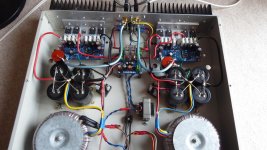Just a question to slowhands regarding the lack of source resistors on the O/P stage:
This worried me but I was thinking maybe this does not matter because of the positive temperature coefficient that MOSFETs possess. If one did draw more current it would automatically turn down and not " carry all the current until it blows" This inbuilt characteristic negates the need for source resistors as they would automatically all settle down and draw a similar current but ideally each one would need to be on its own heatsink and not connected heat transmission-wise for the effect to work perfectly? ....Any views on this please slowhands?....Les
I mentioned there are no source resistors. MOSFETs can differ a lot in threshold voltage and on resistance. So there is no guarantee that 3 random parts in parallel will share evenly. Source resistors partly equalize the currents, but matching would be good too. I know they waste power, I know they cost money, but as it is you can have one MOSFET carrying all the current, until it blows, then the next carries all the current and blows, and finally number three blows. That's one scenario. They need to be matched and forced to share load.
This worried me but I was thinking maybe this does not matter because of the positive temperature coefficient that MOSFETs possess. If one did draw more current it would automatically turn down and not " carry all the current until it blows" This inbuilt characteristic negates the need for source resistors as they would automatically all settle down and draw a similar current but ideally each one would need to be on its own heatsink and not connected heat transmission-wise for the effect to work perfectly? ....Any views on this please slowhands?....Les
Last edited:
Hello LJM....I am about to make another of your excellent amplifiers (L20 v9.2 shown in photo) and wish to buy a MOSFET design. I would like to buy either the L150W or the L15....so I was wondering WHY is the L15 better than the L150W please?...Very much obliged if you could take the time to help me here...Thanks.
Because I measure with instruments.
APSYS 2722。
The result is that L15 has less distortion, and of course l150w is not bad.
But in fact. L20v9.2 is better.
Because I measure with instruments.
APSYS 2722。
The result is that L15 has less distortion, and of course l150w is not bad.
But in fact. L20v9.2 is better.
Hi ljm, I saw that there is also version 10 of the L20.
Which is better, version 9.2 or 10?
Currently I have the L12.2 and I am completely satisfied. So I want another amp and I think the L20 is a good choice.
Because I measure with instruments.
APSYS 2722。
The result is that L15 has less distortion, and of course l150w is not bad.
But in fact. L20v9.2 is better.
Thank you very much LJM for your reply. I agree that the L20v9.2 amplifiers are excellent. It is completely neutral and transparent with immense detail and ambience. I have changed the input capacitor to a 12uF Polypropylene type. I am always amazed how cool it runs. Thank you so much for your superb designs.
Attachments
Hi...The dual supplies produce around +/-45V. I have not tested it but I think will produce around 85W RMS and hopefully nearly double that at 4 Ohms as there should be very little voltage drop off from the transformers which are rated at 250VA each as far as I can remember. That is plenty enough power for my room. Remember you would need 170W just to gain another 3db of loudness, which is hardly perceptible.
Last edited:
Because I measure with instruments.
APSYS 2722。
The result is that L15 has less distortion, and of course l150w is not bad.
But in fact. L20v9.2 is better.
Hello LJM, As for the L15, can it run at 70V rail voltages? I have a PS which provides +/- 72V without load.
Regards,
Laszlo
- Home
- Amplifiers
- Solid State
- New Design L 150W FET Amplifier
